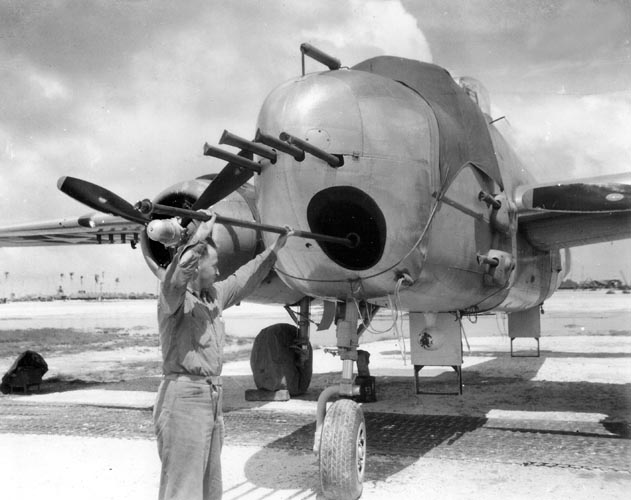Candygram for Mongo! Candygram for Mongo!
B-25
Happy Easter from Shangri-La
The first rule of gunfighting is “Bring enough guns”

38th Bomb group, 71st Bomb Squadron
Ground crew member posing next to a B-25 strafer (J model?) and it’s 14 .50 cals.
When there is lead in the air, there is hope in the heart
Tragedy Above the Bismarck Sea


On February 26, 1943, a Japanese convoy was spotted by Allied forces at Rabaul. At this point in the war, the Japanese were trying to build up their strength in New Guinea after losing control of the Solomon Islands. Fifth Air Force would try to keep a close eye on this convoy, but due to the weather, could not watch it for two days. On March 1st, the weather finally cleared up enough for a 90th Bomb Group crew to see the convoy on its way from Rabaul to Lae. The crew immediately reported the situation as well as the size of the convoy. With six troop transports, two vessels carrying aviation fuel, a boat full of Japanese marines, eight destroyer escorts, and 100 fighter planes, this was not a target to be missed. B-17s from the 63rd Squadron were soon sent to bomb the convoy, but were thwarted by weather. That night, 1/Lt. William Crawford, Jr.’s crew set off to find and monitor the convoy while Fifth Air Force got ready to attack.
Read the rest here: Tragedy Above the Bismarck Sea
The Same Places, 70+ Years Apart—Six More WWII Bases Then and Now
Located on the coast of a natural harbor on the eastern coast of New Britain, an island in the Southwest Pacific, Rabaul was a German colony in the 1900s that was captured by the Australians in World War I. Two nearby volcanoes, Vulcan and Tavurvur, erupted violently in 1937, destroying most of the city. After World War II started, it was captured by the Japanese in January 1942, after which it was transformed into a major stronghold with approximately 97,000 troops that would easily fend off Allied attacks until October and November 1943. While the Allies continued to advance towards Japan, they cut off Japanese supply routes to Rabaul and continued to bomb the city and surrounding area. It was officially surrendered at the end of the war. After the war was over, the city became a trading hub until Tavurvur erupted in 1994, once again destroying a large part of the city. Developments closest to the volcano were never rebuilt.
Source: The Same Places, 70+ Years Apart—Six More WWII Bases Then and Now
The only kind of PBJ I like
I like peanut butter. I like some jellies. I do not like peanut butter AND jelly. Ergo, this is my idea of a good PBJ (technically a PBJ-1H I believe)

MTech Sgt Lloyd M Staggs cleans the bore of a 75mm cannon mounted in the nose of a PBJ-1 Mitchell of Marine Squadron VMB-613, Kwajalein, April 1945. Note also the six Browning M2 .50 cal machine guns. ww2dbase
How did the USN and USMC end up with USAAF B-25s? Were they impressed enough after the Doolittle Raid to finagle their own (mostly) land based medium twins? Nope, it had more to do with some inter-service give and take:
The PBJ had its origin in an inter-service agreement of mid-1942 between the Navy and the USAAF exchanging the Boeing Renton plant for the Kansas plant for B-29 Superfortress production. The Boeing XPBB Sea Ranger flying boat, competing for B-29 engines, was cancelled in exchange for part of the Kansas City Mitchell production. Other terms included the inter-service transfer of 50 B-25C and 152 B-25D to the Navy. The bombers carried Navy bureau numbers (BuNos), beginning with BuNo 34998. PBJ-1 stood for Patrol (P) Bomber (B) built by North American Aviation (J), first variant (-1) under the existing American naval aircraft designation system of the era.
Thanks for the assist Mr Wikerpedia!
So there you have it, a PBJ I can enjoy!


